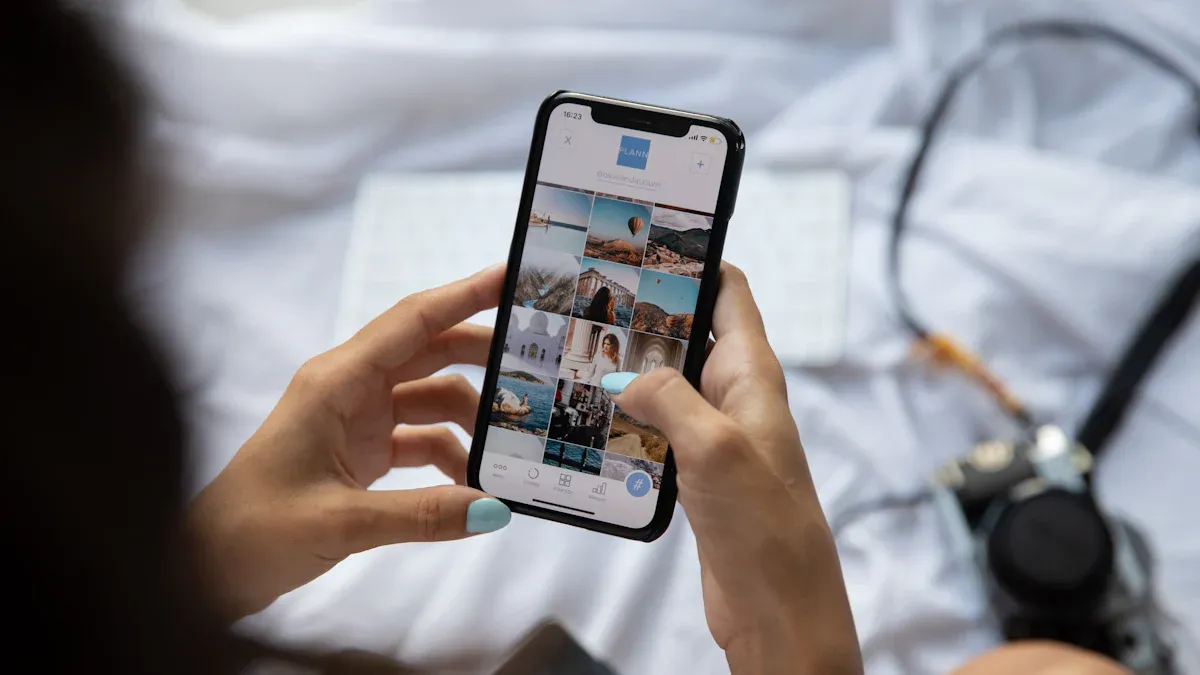The Future of Brand Equity: Influencers, UGC, and Ambassadors

In today’s world of social media and ecommerce marketing, trust and community matter most. People don’t just buy things—they connect with brands they believe in. Did you know 82% of people want brands to share their values? That’s a big deal! It shows how much people want real connections.
This change has reshaped how brands grow. Influencers, ambassadors, and user-made content (UGC) are now key. For instance, studies show 79% of buyers trust UGC from small influencers. These ideas aren’t just popular—they’re changing how brands earn loyalty in the realm of social media and ecommerce marketing.
Key Takeaways
Work with influencers for a long time to build trust. This can make people interact more and lower content costs.
Content made by users (UGC) is great for brands. It feels real and can help sell more products. Use UGC to connect better with your audience.
Pick ambassadors who truly match your brand's values. Their honesty can make your brand stronger and gain loyal customers.
Use UGC tools to make your campaigns easier to manage. These tools help gather and share content, keeping marketing simple and organized.
Be ready for new trends in social media and online shopping. Try new tools and ideas to keep your brand fresh and competitive.
The Role of Influencers in Building Brand Equity

Working Together, Not Just One-Time Deals
Long-term influencer partnerships work better than one-time deals. Why? They build trust and make the brand feel real. When influencers stick with a brand, their content feels more honest. This helps them understand the brand’s values and share them better.
For example, brands working with influencers for over a year see 300% more engagement. Long-term deals also cut content costs by 40-60%. Look at Nike and Cristiano Ronaldo. Since 2003, their partnership has made over $1 billion. This shows how lasting relationships can create strong emotional bonds and boost brand value.
Strategy Type | Success Rate |
|---|---|
Always-On Approach | |
Non-Always-On Approach | Not Available |
By teaming up for the long haul, you connect better with influencers and their fans. This isn’t just about selling—it’s about building a loyal community.
Being Real and Matching Values
Being real is key in influencer marketing. People trust influencers who are honest and relatable. When an influencer’s values match your brand, their followers notice. This builds trust, which is super important.
Fake or forced content can hurt your brand. To avoid this, ask influencers to be open about their partnerships. Being honest shows you care about trust, which makes people like your brand more.
Take beauty brands like e.l.f. and Rhode. They work with creators who truly love their products. This helps them build loyal fans and real trust. When you focus on being real, you’re not just running ads—you’re making real connections.
Saving Money with Smart Partnerships
Bundling influencer deals can save money and work better. Instead of hiring many influencers for short campaigns, work with a few for longer. This lets you track things like cost per sale and customer loyalty.
Here’s how it works: Team up with a group of creators over time. This lowers costs and improves the quality of engagement. Focus on actions like clicks and purchases, not just likes. Long-term deals also give influencers time to make better content.
Bundling campaigns isn’t just cheaper—it builds strong relationships. This helps you grow loyal customers while staying on budget.
Harnessing the Power of UGC

Why UGC Matters in Social Media and Ecommerce
User-generated content (UGC) is changing how brands connect with people. Why? It feels real, honest, and easy to trust. When you see someone like you using a product, it feels more believable than a fancy ad. That’s why UGC works—it builds trust and brings people together.
Here’s why UGC is so effective:
Instagram posts with UGC get 70% more likes and comments.
On TikTok, UGC works 22% better than brand-made videos.
UGC campaigns have 29% higher conversion rates.
79% of buyers say UGC affects their decisions.
These numbers show UGC isn’t just a trend—it’s a strong way to boost sales and engagement. Adding UGC to your plan helps you connect with your audience in a real way.
Best Types of UGC for Success
Not all UGC works the same. Some types are better for certain goals. Here’s a quick guide:
Photos: 55% of U.S. shoppers say photos help them decide what to buy. A simple picture of someone using your product can make a big difference.
Videos: Short, real videos are perfect for TikTok and Instagram Reels. They’re fun and easy to share.
Reviews and Testimonials: Honest opinions from real users build trust. When people see others loving your product, they want to try it too.
Social Media Posts: Posts with your brand’s hashtag can create excitement and get more people involved.
For example, Nike’s challenges got users to share fitness stories with hashtags like #NikeChallenge. This made people feel part of a group. Starbucks did something similar with their #WhiteCupContest, where customers designed coffee cups. Thousands joined, creating a stronger bond with the brand.
When you use the right UGC, you’re not just showing off your product—you’re sharing a story your audience cares about.
Using UGC Platforms for Better Campaigns
To get the most from UGC, you need good tools and ideas. UGC platforms help you collect, organize, and share content easily. Here’s how to use them:
Make a branded hashtag for your campaign. This helps users share content and makes it easy to find.
Add UGC to shoppable galleries on your website. Seeing real people use your product can inspire others to buy.
Use UGC in emails. A photo or review can make emails more interesting.
Run contests like “Customer of the Month” to get people involved.
Add UGC to retargeting ads to remind shoppers why they should choose your brand.
For example, goPure used UGC videos and got a 26% conversion rate. Ava Estell earned 743,000 GBP in sales and kept visitors on their site for 4,000 extra hours. These examples show how UGC platforms turn customer content into real success.
When you add UGC to your campaigns, you’re not just advertising—you’re letting your customers be part of your brand’s story. That’s the power of UGC done right.
Ambassador Programs for Long-Term Advocacy
Finding and Choosing the Best Ambassadors
Picking the right ambassadors is like choosing trusted teammates. They should truly care about your brand and share its story honestly. Start by finding people active on social media. They should engage their followers and spark real conversations.
Here’s what to look for when choosing ambassadors:
Criteria | What It Means |
|---|---|
Social Media Activity | Pick people who post often and talk with their audience. |
Engagement | Choose those who connect deeply with their followers. |
Being Genuine | Find ambassadors who share your brand’s values and goals. |
Creativity | Look for people who tell great stories about your products. |
Dependability | Make sure they are reliable and represent your brand well. |
Past Work | Check their past partnerships to see how effective they were. |
By focusing on these traits, you’ll build a strong team that boosts your brand’s trust and message.
Supporting Ambassadors with Tools and Rewards
Ambassadors do better when they feel appreciated. Give them tools like branded kits, early product access, or special discounts. These perks make them feel part of your brand and excited to share it.
Rewards also keep ambassadors motivated. Offer things like commissions, free items, or VIP perks. A reward system with levels can make it fun and encourage loyalty.
Always listen to your ambassadors. Ask for their ideas and show how you use their feedback. When they see their input matters, they’ll feel more connected and committed to your brand.
Tips for Running an Ambassador Program
Running an ambassador program needs clear goals and good communication. Start by deciding what you want, like more social media activity, website visits, or sales. Track things like views, reach, and reviews to see how you’re doing.
Here’s an easy way to manage your program:
Set clear goals and share them with your ambassadors.
Watch performance to see who’s doing the best.
Give updates and celebrate achievements together.
Brands like Lululemon succeed by building strong ambassador communities. But the Fyre Festival shows what happens when trust is missing. Learn from these examples to create a program that builds loyalty and long-term success.
Integrating Strategies for Maximum Impact
Combining Influencers, UGC, and Ambassadors
Mixing influencers, UGC, and ambassadors makes marketing stronger. Each one adds something special, but together, they work even better. Picture an influencer sharing honest posts, supported by UGC from real users, and ambassadors promoting your brand for the long term. This teamwork builds trust and gets people involved.
To make this process easier, use tools to manage campaigns. These tools help you save time, track results, and stay organized. Here’s what they can do:
Feature | What It Does |
|---|---|
Easy campaign management | Automates tasks like approving content and sending products. |
Real-time success tracking | Tracks clicks, likes, and other important numbers. |
Creator relationship tools | Helps you stay connected with influencers and ambassadors. |
Better ads with UGC | Uses customer content to make ads cheaper and more effective. |
By combining these strategies, you simplify your work and get better results. It’s not just about running ads—it’s about creating a system that helps your brand grow.
Creating a Cohesive Multi-Channel Marketing Approach
Using many channels together helps you reach more people. Whether it’s email, social media, or influencers, each one plays a part. The trick is making them work as a team.
For example, email marketing gives $42 back for every $1 spent. SEO brings in 40% of revenue through free search traffic. Influencer marketing also gives great returns. When you combine these, you guide customers from learning about your brand to buying your product.
Here’s why this matters:
89% of marketers say using many channels together is important.
75% have some success with this method.
Only 20% feel they’re doing it really well, so there’s room to improve.
To stand out, keep your message the same everywhere. Use the same style, colors, and words on all platforms. This makes your brand easy to recognize and trust.
Staying Ahead of Trends in Social Media and Ecommerce Marketing
Social media and ecommerce change fast. To stay ahead, follow trends and try new ideas. Being honest and real is more important than ever. Brands like Patagonia share their eco-friendly efforts and build loyal fans by being genuine.
Short videos are another big trend. Apps like TikTok and Instagram love quick, fun videos, so they’re great for influencer marketing. Watching social media stats can also help you spot new trends and adjust your plans quickly.
Here are some key facts to remember:
Digital ads worldwide could reach $786.2 billion by 2026.
Companies that test 10-15% of their budget do better.
Collecting your own customer data gives you an advantage.
By staying updated and flexible, your strategies will stay fresh and effective. This keeps your brand relevant in the fast-changing world of social media and ecommerce.
Measuring Success and Adapting for the Future
Key Metrics for Evaluating Campaign Performance
To see if your marketing works, track important numbers. These numbers show what’s good and what needs fixing. Focus on these key performance indicators (KPIs):
KPI Type | What It Tells You |
|---|---|
Return on Investment | How much profit you earn compared to what you spend. |
Customer Acquisition Cost | How much it costs to get a new customer. |
Conversion Rate | The percentage of people who take an action, like buying or signing up. |
Engagement Metrics | How people interact with your content, like clicks, shares, or comments. |
You can group KPIs into three main types:
Financial KPIs: These focus on money, like profits and revenue growth.
Acquisition KPIs: These measure how well you attract new customers, like CAC and conversions.
Retention KPIs: These show customer loyalty, like churn rate and lifetime value.
Watching these numbers helps you know how well your campaigns are doing.
Tools and Techniques for Tracking Success
Tracking success is easier with the right tools. These tools help you collect data and make smart choices. Here are some helpful tools:
Tool/Technique | What It Does |
|---|---|
Data Analytics Tools | Helps you see and understand your data clearly. |
Creative Marketing Metrics | Shows how well your campaigns perform using real numbers. |
Regression Analysis | Finds links between your spending and your results. |
Optimization Models | Helps you use your resources wisely for better outcomes. |
To use these tools well:
Pick software that matches your needs.
Teach your team how to read and use the data.
Mix numbers with customer feedback for a full view.
For example, testing different ideas can show what works best. This helps you improve your strategy for better results.
Adapting to Emerging Trends and Technologies
Marketing changes fast, so staying updated is key. New tools like AI and machine learning are very helpful. They let you personalize experiences, predict trends, and manage stock better.
“Being flexible in marketing helps businesses stay ahead by reacting quickly to changes.”
Here’s why adapting is important:
81% of marketers think customer experience will lead competition soon.
Predictive tools help you see trends and plan ahead.
AI tools can scan markets, predict results, and adjust plans quickly. This keeps your brand ready for what’s next.
Building a strong brand now needs influencers, UGC, and ambassadors. Why? They make brands feel real, which 90% of people value. UGC feels 2.4 times more honest than ads. Brands like Lululemon and Coca-Cola show this by inspiring millions of user posts with fun campaigns.
To stay successful, you must try new ideas and tools. Focus on building real connections and testing smart strategies. When you invest in trust and technology, you’re not just selling—you’re creating lasting loyalty.
FAQ
What’s the difference between influencers and brand ambassadors?
Influencers help promote your brand for short campaigns. They focus on reaching their followers quickly. Ambassadors work with your brand for a long time. They build stronger connections with your customers. Think of influencers as sprinters—they’re fast but short-term. Ambassadors are like marathon runners—they last longer and go deeper.
How can I encourage customers to create UGC?
Make it exciting and rewarding! Hold contests or use branded hashtags. Offer rewards like discounts or special perks. Ask customers to share photos using your product. When you feature their content, they’ll feel appreciated and want to share more.
Tip: Share user posts on your social media to inspire others!
Are long-term influencer partnerships really worth it?
Yes, they are! Long-term deals build trust and feel real. When influencers promote your brand often, their followers believe it more. You also save money by combining campaigns. Influencers make better content when they know your brand well.
What tools can I use to manage UGC campaigns?
Tools like Later, Yotpo, and TINT make UGC easy. They help you collect and organize user content. You can also track how well your campaigns are doing. These tools save time and keep everything in order.
How do I measure the success of my ambassador program?
Check things like engagement, sales, and referrals. Use tools to see how ambassadors help your brand grow. For example, track new customers from their referral codes. This shows what’s working and what needs fixing.
Note: Review results often to keep your program strong.
See Also
Exploring Key Features of Leading Influencer Discovery Tools
Essential Metrics for Measuring Influencer Marketing ROI 2025
Best Influencer Analytics Tools to Consider in 2025
Effective Strategies to Enhance Influencer Marketing ROI 2025
